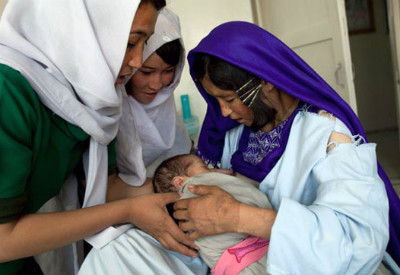By Sune Engel Rasmussen
For years, declining death rates among pregnant women have been hailed as one of the great gains of foreign aid in Afghanistan.
In reality, however, Afghan women dying in pregnancy or childbirth may be more than twice as high as numbers provided by donors would suggest.
Since 2010, published figures have shown maternal mortality rates at 327 for every 100,000 live births, a significant drop from 1,600 in 2002. Yet recent surveys give a different picture.
In one unpublished study, the Afghan government found an average level of maternal deaths between 800 and 1,200 for every 100,000 live births, according to aid workers in Kabul who have seen the research.
If accurate, this would mean that women in Afghanistan – despite more than 15 years of international aid aimed at improving maternal mortality figures – may be dying from maternal complications at rates similar to those found in Somalia and Chad, and only surpassed by South Sudan.
In another review, the UN Population Fund (UNFPA) found as many as 1,800 maternal deaths a year in the remote Afghan province of Ghor. Nine out of 11 provinces had higher death rates than the number normally used by donors.
Both the UNFPA mortality numbers and the government’s own survey have yet to be released. A spokesman for the ministry of public health said the survey was not ready to be publicised yet, and declined to discuss findings.
The country’s emphasis on training midwives in recent years is slowly building numbers. Yet, despite this improved capacity, driving up numbers of health personnel is only half the solution, according to Bannet Ndyanabang, UNFPA’s Afghanistan representative: “Training is not the only thing. They have to be deployed in the areas where they are needed. It doesn’t matter that you have health centres if they’re not staffed with skilled personnel. [Midwives and nurses] have to be given incentives to work in rural areas.”
One reason for the discrepancy in the figures is a lack of reliable data. Collecting such information in Afghanistan is notoriously difficult. Worsening security prevents even officials from the ministry of public health, let alone foreigners, from travelling to rural areas.
In a recent audit of $1.5bn (£1.2bn) donated by the US to Afghan healthcare, the Special Inspector General for Afghanistan Reconstruction – the US congressional watchdog – criticised the use of unreliable data to prop up claims of progress in Afghanistan.
According to Sigar, “missions are required to be transparent and communicate ‘any limitations in data quality so that achievements can be honestly assessed’. In all cases Sigar reviewed, USAid did not disclose data limitations.”
Sigar said similarly selective data use lay behind USAid claims that life expectancy in Afghanistan has risen by 22 years. More recent surveys by the World Health Organization show relatively modest increases of six and eight years for men and women respectively.

An Afghan midwife helps a mother nurse her newborn baby at the Bamiyan Provincial hospital, in Bamyan province, 2009. (Photo: Paula Bronstein)
A USAid spokesperson said: “In Afghanistan, a country suffering from decades of conflict, reliable health and population data is scarce and difficult to obtain. USAid strives to use the best available data for programming decisions and invests to improve data quality for measuring progress. This commitment includes our continued support for independent nationwide surveys on the state of the health sector. These surveys, and the methodology they use, are publicly available.”
More reliable data is available, however.
While numbers used by international donors were based on samples from three of the 360 districts in existence at the time, the UNFPA survey was much more extensive, covering 70% of households in 11 of the country’s 34 provinces.
The UNFPA did not survey southern and eastern provinces, where rates are almost certainly high because conflict and poor infrastructure make healthcare inaccessible to millions of women.
In addition, a 2013 study by the Institute for Health Metrics and Evaluation at the University of Washington reported 885 annual maternal deaths in Afghanistan. According to the researchers, that was an increase of 24% on a decade earlier.
In Afghanistan, reality often conflicts with official statistics. The UK government, for instance, claims that 85% of Afghans are now covered by basic health services.
Yet, in a 2014 Médecins Sans Frontières report, four out of five Afghans said they did not use their closest public clinic because they believed the quality of services and availability of staff was so poor. According to the UN Office for the Coordination of Humanitarian Affairs, 9 million Afghans are without access to basic health services.
Healthcare has also been a key priority for the British government in Afghanistan, though it’s not clear exactly how much money goes specifically to reducing mortality among pregnant women.
Since 2002, the UK has provided more than $1.7bn (£1.4bn) to the Afghanistan Reconstruction Trust Fund, which allocates a significant portion to healthcare. Healthcare for mothers is a key priority, the UK embassy in Kabul said.
In a country where reliable data is so elusive, a stronger focus on monitoring progress, and further investment in it, is desperately needed, or the benefits of the large amount of aid going into healthcare will remain unclear.
Originally published on Jan. 30, 2017



